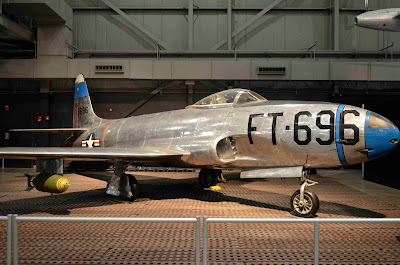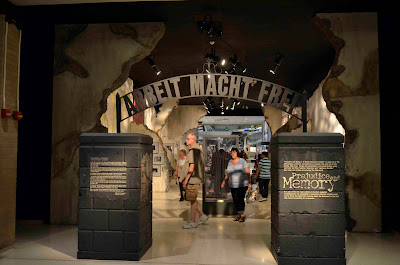It is a huge understatement to say this is a large museum. The exhibits from the early years of flight through the space shuttle program fill four massive aircraft hangers. AAA allows four hours to tour the facility. At the end of six hours we had seen all of the museum but most of it on brief walkthroughs. Docents recommend three days or more. More than large, this is an excellent facility for showing the military history of flight with real planes. Several docent tours are offered.
A Shooting Star, the first American aircraft to exceed 500 mph in level flight.
A Douglas X3, designed to be the first aircraft to fly at twice the speed of sound.This Ryan X 13 was designed to take off vertically, go to level flight then land vertically. This was to be used if the enemy destroyed our runways so planes could not take off or land normally.
He explained the toilet rule, the first one to use it cleans it.

The plane was multi-purpose, used for passengers, hospital litters, cargo, and parachutists. The planes in this gallery includes planes from more recent wars up until the end of the space shuttle era.
The Presidential Gallery displays actual president planes. The FDR plane flew Roosevelt to and from Yalta, his last flight. Changes in Air Force One, besides the actual plane, included up dates in the cooking area, seating, toilets and space for the Presidents. The names of the planes changed, too. Sacred Cow flew FDR and had an elevator to lift him.
Truman flew on the Independence (his home town) and Eisenhower on the Columbine (state flower of Colorado, Mamie’s home state).
The name became Air Force One, call numbers SAM 26000, with Kennedy and this plane served eight presidents.
A smaller Jetstar flew the Johnson’s from their ranch to Austin.
Flight deck of mock up of space shuttle
This is a photo from the missile gallery
One of the few remaining B36s
First practical thermonuclear bomb
The Holocaust Exhibit, a touring sponsored by Robert Lauder, uses voices of Jewish residents of Dayton who were interned as well as some POWs who were interned instead of put in POW camps where they would have had “better” treatment.
This uniform of an internee in Buchenwald is the rarest item in exhibit.
WWII Barrage Balloon used over London during the blitz.
WWI Heavy Bomber
Flying Tiger
Doolittle Tokyo Raider Bomber
The display on women and African Americans during WWII pointed out the discrimination they faced not only in their responsibilities during the war but also the denial of veterans benefits after their service.
This Nose Art is from WWII.
Jerry is dwarfed by an airplane wheel.
The Memorial Garden has sculpture honoring airmen. This one honors pilots who flew over the Himalayas during WWII.
This is a Vietnam memorial.



























We visited this museum in 2002. I remember being particularly impressed with the unexpected presence Holocaust section. I do remember that we did not get to see everything in any detail because of the vastness of the displays and I seem to remember the weather was not conducive to going out on the flight line.
ReplyDeleteI have an uncle, still alive, who worked at Wright Patterson AFB. He is a Physicist and worked on the possibility of missile born nuclear weapons. He turned to teaching physics after that assignment. Retired as Chair of the Syracuse Physics Dep't